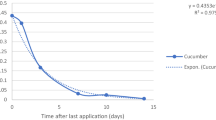Abstract
The residual characteristics and risk assessment with respect to cyazofamid and its metabolite 4-chloro-5-p-tolylimidazole-2-carbonitrile were monitored in case of Korean cabbage at different preharvest intervals during a greenhouse trial. The 0.02 kg a.i/ha of cyazofamid was sprayed twice on seven-day intervals (i.e., on day 0, 7, 14, and 21 before harvest). The liquid chromatography–tandem mass spectrometry analysis was used to monitor the residual amount of fungicide. The matrix-matched calibration curves with respect to the cyazofamid in Korean cabbage exhibited good linearity (R2 ≥ 0.999) and acceptable recoveries of 84.1%–114.9%. The biological half-life of cyazofamid in Korean cabbage was 3.18 days. During the treatment, the preharvest residue of cyazofamid in Korean cabbage 14 days before harvest (0.80 mg/kg) was lower than that specified by the MFDS–MRL (Ministry of Food and Drug Safety-Maximum Residue Limit, 2.0 mg/kg) and should be recommended as the safe preharvest-interval application limit. The hazard quotient showed low toxicity (70.58%) during the risk assessment study of cyazofamid.


Similar content being viewed by others
References
Angioni A, Del Real AA, Russo M, Melis M, Cabitza F, Cabras P (2003) Triazole fungicide degradation in peaches in the field and in model systems. Food Addit Contam 20:368–374
[EFSA] European Food Safety Authority (2016) Peer review of the pesticide risk assessment of the active substance cyazofamid. EFSA J 14:4503–4527
Fantke P, Juraske R (2013) Variability of pesticide dissipation half-lives in plants. Environ Sci Technol 47:3548–3562
Gonzalez-Alvarez M, González-Barreiro C, Cancho-Grande B, SimalGándara J (2012) Impact of phytosanitary treatments with fungicides (cyazofamid, famoxadone, mandipropamid and valifenalate) on aroma compounds of Godello white wines. Food Chem 131:826–836
Hwang JI, Kim HY, Lee SH, Kwak SY, Zimmerman AR, Kim JE (2018) Improved dissipation kinetic model to estimate permissible pre-harvest residue levels of pesticides in apples. Environ Monit Assess. 1:1. https://doi.org/10.1007/s10661-018-6819-8
Lee H, Kim E, Lee JH, Sung JH, Choi H, Kim JH (2014) Analysis of cyazofamid and its metabolite in the environmental and crop samples using LC-MS/MS. B Environ Contam Tox 93(586):590
Lee H, Kim E, Moon J-K, Zhu Y-Z, Do J-A, Oh J-H, Kwon K, Lee Y, Kim J-H (2012) Establishment of analytical method for cyazofamid residue in apple, mandarin, Korean cabbage, green pepper, potato and soybean. J Korean Soc Appl Biol Chem 55(2):241–247
Lee H, Kim E, Shin Y, Lee J, Hur H, Kim J (2016) Identification and formation pattern of metabolites of cyazofamid by soil fungus Cunninghamella elegans. Appl Biol Chem 59:9–14
Lozowicka B (2015) Health risk for children and adults consuming apples with pesticide residue. Sci Total Environ 502:184–198
Mitani S, Araki S, Yamaguchi T, Takii Y, Ohshima T, Matsuo N (2001) Antifungal activity of the novel fungicide cyazofamid against Phytophthora infestans and other plant pathogenic fungi in vitro. Pestic Biochem Physiol 70:92–99
Opolot M, Lee SH, Kwak SY, Sarker A, Cho SC, Kim HJ, Jeong HR, Kim JE (2018) Dissipation patterns of insecticide sulfoxaflor in Spinach and Korean Cabbage. Korean J Pestic Sci 22(4):316–326
Pang N, Dou X, Hu J (2019) Residue behaviours, dissipation kinetics and dietary risk assessment of pyaclostrobin, cyazofamid and its metabolite in grape. J Sci Food Agric 99:6167–6172
Regueiro J, Olguín N, Simal-Gandara J, Sunol C (2015) Toxicity evaluation of new agricultural fungicides in primary cultured cortical neurons. Environ Res 140:37–44
Singh N, Tandon S (2015) Dissipation kinetics and leaching of cyazofamid fungicide in texturally different agricultural soils. Int J Environ Sci Technol 12:2475–2484
Stenersen J (2004) Chemical pesticides: mode of action and toxicology. CRC Press, Taylor and Francis Group, Boca Raton, FL
Takeshi O, Terumasa K, Shigeru M, Norifusa M, Toshio N (2004) Development of a novel fungicide, cyazofamid. J Pestic Sci 29:136–138
[US EPA] United States Environmental Protection Agency (2004) Pesticide fact sheet: cyazofamid. Accessed Nov 7, 2019
Wu SZ, Yu WW, Sun CY, Zheng KM, Zhang HZ, Huang M et al (2018) Simultaneous determination of residues of metalaxyl, cyazofamid and a cyazofamid metabolite in tobacco leaves and soil by liquid chromatography with tandem mass spectrometry. Biomed Chromatogr 32:e4161
Xu T, Feng X, Pan L, Jing J, Zhang H (2018) Residue and risk assessment of fluopicolide and cyazofamid in grapes and soil using LC-MS/MS and modified QuEChERS. RSC Adv. https://doi.org/10.1039/c8ra06956e
Xu ZL, Zhang CP, Yu JZ, Zhang CR, Wu M, He HM et al (2016) Field investigations of dissipations and residues of cyazofamid in soil and tomato: risk assessment of human exposure to cyazofamid via tomato intake. Environ Sci Pollut R 24:3483–3492
Yang Q, Liu N, Zhang S, Wang W, Zou Y, Gu Z (2019) The dissipation of cyazofamid and its main metabolite CCIM during tomato growth and tomato paste making process. Food Addit Cont. https://doi.org/10.1080/19440049.2019.1626999
Acknowledgments
This work was supported by the 2019 research fund (Project No. 00-19-8-064400) of the Ministry of Food and Drug Safety, Korea.
Author information
Authors and Affiliations
Corresponding author
Rights and permissions
About this article
Cite this article
Sarker, A., Lee, SH., Kwak, SY. et al. Residue Monitoring and Risk Assessment of Cyazofamid and Its Metabolite in Korean Cabbage Under Greenhouse Conditions. Bull Environ Contam Toxicol 105, 595–601 (2020). https://doi.org/10.1007/s00128-020-02972-0
Received:
Accepted:
Published:
Issue Date:
DOI: https://doi.org/10.1007/s00128-020-02972-0




